Falcón
Falcón State (Spanish: Estado Falcón, IPA: [esˈtaðo falˈkon]) is one of the 23 states (estados) that constitute Venezuela. The state capital is Coro.
Falcón | |
|---|---|
 Flag 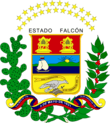 Coat of arms | |
| Motto(s): | |
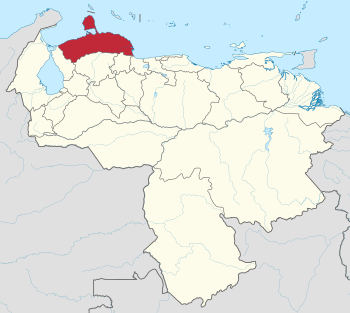 Location within Venezuela | |
| Country | Venezuela |
| Created | 1864[c] |
| Capital | Coro |
| Government | |
| • Body | Legislative Council |
| • Governor | Víctor Clark |
| • Assembly delegation | 6 |
| Area | |
| • Total | 24,800 km2 (9,600 sq mi) |
| Area rank | 10th |
| 2.71% of Venezuela | |
| Population (2011 census) | |
| • Total | 902,847 |
| • Rank | 11th |
| 3.45% of Venezuela | |
| Time zone | UTC-04:00 (VET) |
| ISO 3166 code | VE-I |
| Emblematic tree | Cují yaque (Prosopis juliflora) |
| Website | www |
| ^[c] As Coro State; in 1874, it was renamed as Falcón State. | |
History
The area was first explored in 1499 by Juan de la Cosa and Américo Vespucio, as part of an expedition supervised by Alonso de Ojeda. The origins of Falcon go back to 1527 when the city of Coro was founded and received the name of "Santa Ana de Coro" by Juan Ampíes, who did it in the name of his father for a conquest that received the same name in Santo Domingo. In 1811, when Venezuela declared its independence, Coro remained faithful to the Spanish Crown and merged with the Province of Maracaibo, until Fernando VII decreed the creation of the Province of Coro in 1815. Finally in 1821 when it was liberated by Josefa Camejo during the War of Independence it appears as a province of the department of Zulia of the Republic of the Great Colombia. In 1830, with the separation of Venezuela from this republic, it was formed in one of its provinces.
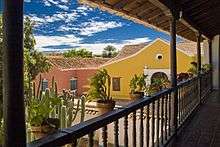
In 1856 it is confirmed its category of province integrated by the cantons of Coro, San Luis, Casigua, Costa Arriba, Cumarebo and Paraguaná. In 1859, after the events of the initiation of the Federal War that took place on February 20 in Coro, it is declared the Independent State of Coro. In 1864 it became a federal state, part of the United States of Venezuela, as the confederation was called.
In 1872 it was renamed Falcon State, in honor of the Federal War leader Juan Crisóstomo Falcón. In 1879, along with Lara and Yaracuy, minus the Department of Nirgua, it became part of the Western Northern State. Between 1881 and 1890 it formed with Zulia the State Falcon-Zulia. In 1891 it appears again as an independent state with the name of Falcon. In 1899 it suffers a change of name, recovering for a short period of time its historical denomination of Estado Coro; returning in 1901 with the name that is known at the present time.
In 1899, the territory comprising the towns of Tucacas and Chichiriviche, which until that year belonged to the Great State of Lara, was annexed, giving to the latter what is now the municipality of Urdaneta.
Coro, the capital, founded with the name of Santa Ana de Coro, was declared National Monument in 1950, and UNESCO has named it Cultural Patrimony of the Humanity in 1993.
Geography
Falcon State is located in the north of the geographic region called the Corian System. To the south, it is made up of medium altitude mountain ranges configured from east to west, which in the eastern part of the state reach the Caribbean forming maritime valleys. While the western part, from the city of Coro there is a coastal plain that runs parallel to the Gulf of Venezuela. To the north lies one of the most characteristic geographic features that make up the Venezuelan coast: the Paraguana Peninsula, linked to the mainland by the isthmus of Los Medanos de Coro.
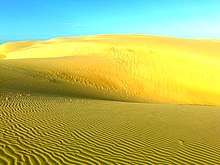
Climate
The semi-arid climate of scarce rainfall dominates the western coast and the Paraguaná peninsula. In Coro there are 417 mm of rain per year, which usually falls in dry years, with an average temperature of 28.4 °C, while in Punto Fijo there are 316 mm of annual rainfall with average temperatures of 27.6 °C. The extremely dry desert conditions, with rainfall of less than 300 mm, are recognised on the western coasts of Cordoba and above all on the isthmus of Los Médanos de Coro, with average annual temperatures of between 28 and 29 °C. In the eastern coastal sectors, rainfall increases from 800 to 1200 mm per year, always with high temperatures. Somewhat more favorable, with temperatures between 25 and 27 °C, are the climatic conditions of the mountainous foothills, recognizing a sub-humid climate in the higher altitudes of the Sierras de San Luis and Churuguara, with annual rainfall of 1300 mm and average temperatures of 22 °C.
Soils
On the coast line they are calcareous, and between the Lara and Falcón mountains they are clayey. They vary in quality, but in general the availability of land for traditional agriculture can be classified as low, with 89% of very low potential, 3% of low potential and 6% of moderate potential.
Only 2% of it, located in the Southeast valleys and alluvial areas, basins with very high potential. The limitations of the arid and semi-arid soils come from salinity, water deficit caused by low rainfall, low concentration of organic matter and the influence of climatic agents such as wind.
Relief
The Corian System of Falcon State presents a diversity of landscapes ranging from coastal plains on its Caribbean side, to mountain ranges formed by valleys and hills, in an area of transition between the two major mountain systems of the country. The Sierra de San Luis has the highest altitude of the entire system of basins of that state, but are very modest heights whose maximum does not exceed 1600 meters (Cerro Galicia). Cerro Santa Ana is a natural monument located in the center of the Paraguaná peninsula. Unlike the rest of the peninsula, the characteristics of Santa Ana Hill are the contrast between its greenness and the xerophytic vegetation of the Paraguaná area. It has three peaks: the Santa Ana (the highest that ascends to about 830 meters above sea level), the Buena Vista and Moruy.
Hydrography
The state's hydrography is very poor, all the rivers flow into the north, either into the Caribbean Sea or the Gulf of Venezuela. However, the main Venezuelan river of the Caribbean basin, the Tocuyo, bathes a large area of the state flowing into the Caribbean on the East Coast of the state after travelling 423 km. Another river worth mentioning that flows into the Caribbean is the Aroa with a length of 130 km. From the basin of the Gulf of Venezuela, the main ones are the Matícora (201 km) and the Mitare with 120 km.
- Main rivers: Tocuyo, Aroa, Güigüe, Hueque, Matícora, Mitare, Pedregal, Remedios, Ricoa, San Luis.
- Lakes: under the San Luis mountain range in the Cueva del Toro, there is an underground lake, the largest known in Venezuela, called "Río Acarite".
Flora and fauna
The marine flora is very rich. There is a great diversity of algae on the rocky shores and on the reef bottoms. The fishing potential of its waters is enormous and among the species that are extracted are shrimp, octopus, squid, mackerel, corocoro, mullet, horse mackerel, lebranche and dogfish. Other species require protection such as sea turtles and the coastal alligator. The latter inhabits the coastal mangroves of Morrocoy, Cuare and the isthmus, along with the sea shearwater, herons, corocoras, gannets and the flamingo. Among the invertebrates, the Hueque scorpion (Tityus falconensis) stands out, discovered in the caves of the Juan Crisostomo Falcon National Park and which is distributed in a great part of the Falconian territory; the giant scolopendra, which is the largest centipede in the world, and the blue tarantula of Paraguaná (Chromatopelma cyaneopubescens) are also native.
In the cardonales and spines that occupy the lower areas, plants heavily armed with thorns predominate. The cují yaque (Falcón's emblematic tree), broom, yabo, espinito, tunas and cardones are common. Aloe vera and sisal crops are scattered throughout the region. In this environment, bats, savannah rabbits, common foxes, wild mice, iguanas and lizards stand out; and among the birds are the cardinal coriano and the paraulata llanera or chuchube (Mimus gilvus). It is also the endemic site of the Hueque scorpion (Tityus falconensis), a species of native scorpion whose distribution is exclusively from the state of Falcon.
.jpg)
On the upper slopes of the mountains, cloud forests dominate where an enormous variety of ferns and palms grow. In the limestone formations of the sierra you can find the guácharo, as well as interesting birds such as the blacksmith's bell bird and the emerald-billed toucan, and reptiles such as the nibbling turtle, a species endemic to the mountains of the Sistema Coriano.
Geology
Early Cretaceous rocks cover the pre-existing sedimentary units in the South, in what is one of the thickest sections in South America. The rounded hills of the Cocodite table are supported by an ancient igneous-metromorphic complex and a poorly metamorphosed Jurassic succession.
To the east of Vela de Coro and Cumarebo, the foothills are supported by outcrops of the young Tertiary, also present to the north of Urumaco, where the stones are rough and darkened by iron oxide; while the plains concentrated in the lower part of the rivers are alluvial.
The arid plain presents quaternary earthquakes, with elevations sustained by rocks from the upper tertiary.
Municipalities and municipal seats
Falcon State is subdivided into 25 municipalities (municipios), listed below with their administrative capitals, areas and populations.[1]
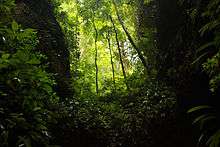
_(8580590685).jpg)
| Municipality | Administrative Capital | Area (km2) | Population Census 2011 | Estimate 30 June 2016 |
|---|---|---|---|---|
| Acosta | San Juan de los Cayos | 757 | 19,045 | 21,272 |
| Bolívar | San Luis | 295 | 8,539 | 9,420 |
| Buchivacoa | Capatárida | 2,657 | 22,897 | 25,470 |
| Cacique Manaure | Yaracal | 190 | 10,874 | 12,149 |
| Carirubana | Punto Fijo | 684 | 239,444 | 276,251 |
| Colina | La Vela de Coro | 582 | 41,510 | 46,631 |
| Dabajuro | Dabajuro | 1,144 | 23,388 | 26,364 |
| Democracia | Pedregal | 2,602 | 9,944 | 11,293 |
| Falcón | Pueblo Nuevo | 1,577 | 46,215 | 55,196 |
| Federación | Churuguara | 1,084 | 29,251 | 33,138 |
| Jacura | Jacura | 1,842 | 11,232 | 12,492 |
| Los Taques | Santa Cruz de Los Taques | 231 | 41,579 | 45,681 |
| Mauroa | Mene de Mauroa | 1,904 | 24,920 | 27,488 |
| Miranda | Santa Ana de Coro | 1,805 | 211,537 | 239,961 |
| Monseñor Iturriza | Chichiriviche | 907 | 19,300 | 21,927 |
| Palmasola | Palmasola | 194 | 7,077 | 8,306 |
| Petit | Cabure | 1,025 | 13,725 | 15,316 |
| Píritu | Píritu | 1,168 | 10,628 | 11,685 |
| San Francisco | Mirimire | 346 | 11,030 | 12,219 |
| Silva | Tucacas | 537 | 32,193 | 41,826 |
| Sucre | La Cruz de Taratara | 840 | 5,781 | 6,379 |
| Tocópero | Tocópero | 83 | 5,519 | 6,010 |
| Unión | Santa Cruz de Bucaral | 975 | 15,660 | 17,441 |
| Urumaco | Urumaco | 752 | 8,349 | 9,044 |
| Zamora | Puerto Cumarebo | 619 | 33,210 | 37,868 |
| Estado Falcón | Coro | 24,800 | 902,847 | 1,030,827 |
The Paraguaná Peninsula comprises the municipalities of Carirubana, Los Taques and Falcón.
Demographics
The population of Falcon State in 2011 was 902,847 inhabitants, while in 2001 there were 763,188 inhabitants. Its population density has risen from 30.8 inhabitants/km² in 2001 to 36.4 inhabitants/km² in 2011. Due to the constant growth of urban areas, a decrease in rural life is observed, with the urban population reaching 67.3% of the total state population in 1990. In 2011 it is estimated that the urban population will be around 600,000 inhabitants, distributed in several cities headed by the conurbation of 228,931 inhabitants formed by the city of Santa Ana de Coro (192,558 inhabitants) and its port La Vela de Coro (36,373 inhabitants); and by the metropolitan area of Punto Fijo, which includes the initial fishing villages of Las Piedras, Carirubana and Punta Cardón with a population of over 300,000 inhabitants.
Other medium sized cities structure their respective areas of influence, highlighting Puerto Cumarebo (22 047 inhabitants), Dabajuro (15 269 inhabitants), Tucacas (12 970 inhabitants), Churuguara (10 800 inhabitants) and Mene de Mauroa (10 302 inhabitants). Moreover, according to the last population census conducted by the National Institute of Statistics in 2011, 55.7% of the population is ethnically recognized as mestizo; 38.9% as Caucasian, concentrated mainly in the city of Punto Fijo; and 4.1% identified themselves as black.
Race and ethnicity
According to the 2011 Census, the estimated racial composition of the population was:[2]
| Racial composition | Est. Pop. | % |
|---|---|---|
| Mestizo | 513,000 | 55.7 |
| White | 358,000 | 38.9 |
| Black | 44,000 | 4.8 |
| Other race | 6,000 | 0.6 |
Main population centers
- Coro, the state capital, is the axis around which the political, cultural and social life of the region revolves. Founded on July 26, 1527. First historical and religious capital of Venezuela. Declared Cultural Heritage of Humanity by UNESCO on December 9, 1993.
- La Vela de Coro, place where the national flag was first raised. Fishing, commercial and artisanal community. Declared next to Coro, Cultural Patrimony of the Humanity.
- Mitare, a town in the west of the state, is a few kilometers from Coro. Its economy is based on the production of goats and shrimp fishing.
- Puerto Cumarebo, capital of the municipality of Zamora Called La Perla de Falcon, it is a fishing, commercial, tourist, agricultural and artisanal zone.
- Punto Fijo, capital of the municipality Carirubana, located in the peninsula of Paraguaná. Commercial city, under the regime of Free Zone of Tourist Promotion and Investment since 1998, is the main economic, industrial, population and productive axis of Falcon.
- Punta Cardón, located in the peninsula of Paraguaná. It has the "Gustavo Riera" Zoo, the only zoo in the state.
- Santa Cruz de Los Taques, discovered in 1502 by Alonso de Ojeda, in this town is the bay of Amuay, a place of great scenic beauty.
- Pueblo Nuevo, for many years was the most important population of the Paraguana Peninsula. Its origin is located between 1730 and 1770. Its economy is based on the artisan activity, represented by excellent ceramists.
- Adícora, main holiday resort in the Paraguaná peninsula, located 60 km north of Coro.
- Tocuyo de la Costa, a town located on the banks of the Tocuyo River in the municipality of Monseñor Iturriza.
- Tocópero, a town that economically lives from livestock, crafts and also has a cement industry that covers the entire state.
- Tucacas, gateway to the state of Falcon on its eastern side. It is mainly a tourist and commercial town.
- Chichiriviche, main tourist center of the Venezuelan northwest. Located on the eastern coast of the state, it gives access to Morrocoy National Park.
- Churuguara, capital of the municipality of Federación. The most important town in the Falcón mountain range, it is a mainly tourist and agricultural town.
- Dabajuro, has the largest commercial movement of the western Falcon. It is a collection center for the trade of agricultural and livestock products.
- Mene de Mauroa, located 188 km west of Coro. Capital of the municipality of Mauroa, its economy is based on agricultural production.
- Mirimire, population of the east of the state. Its economy is based on the production of cattle, tobacco, corn and sugar cane.
- Pedregal, capital of the municipality of Democracia. Cattle and artisan population of the Falconian west.
- San Juan de los Cayos, located 169 km southeast of Coro. Potential producer of fish, bananas, avocado, coconut and cattle.
- Santa Cruz de Bucaral, capital of the Union municipality. It is one of the youngest towns in the Falcon Mountain Range.
- Capatárida, capital of the municipality Buchivacoa, located west of Coro. It has a great historical and cultural tradition, economic activity based on goat breeding and fishing.
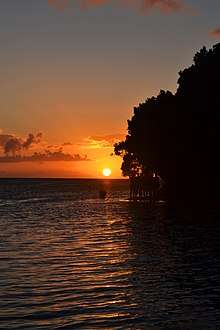
- San Luis, a town located in the Sierra Falcon. It was initially inhabited by Jirajaras Indians.
- Cabure, old settlement of Jirajaras Indians. It was founded in 1769.
- Curimagua, valley in the Falcon Mountains. Cradle of the pre-independence movement led by the Zambo José Leonardo Chirino.
- Borojó, a population of indigenous origin in the municipality of Buchivacoa located west of Falcon.
Economy
Economic resources
Its economic resources include;
- Livestock: poultry, cattle, goats and pigs.
- Fishing: Tuna, catfish, mackerel, corocoro and mullet (marine). Shrimp, crab and lobster, pepitonas and quigua (in) (mollusks).
Agricultural products: Sugar cane, coconut, corn, melon, yam, ocumo and sorghum.
- Forest resources: Candlestick, cedar, cuji, guamo, jabillo and vera
- Mineral resources: Sand, limestone, coal, chromite, gravel, oil and phosphate rocks.
Agriculture and cattle raising
The main economic activity in terms of employment is agriculture, with important crops such as coconut, onions, corn, tomatoes, patilla, melon, coffee, aloe and legumes.
The state of Falcon is the first producer of coconut and copra, goats and their derivatives; second in production of fish and vegetables such as onions, and paprika; third in production of bovine milk and melon. It also has great advantages for the production of dry floor vegetables such as melon, onions, sideburns and tomatoes. The coconut alone has approximately 20,000 hectares cultivated, and there is availability for the expansion of surface area on the eastern coast of Falcon State. Falcon State is one of the main producers of aloe vera in Venezuela, and in the coffee area has a farm of 3500 hectares, but with a provision of 12 700 hectares, distributed in the Sierra de Coro in the south of the federal entity.
In the mountains coffee is cultivated, having prestige the productions in the Sierra de San Luis and Sierra de Churuguara.
In the Eastern Coast there are important plantations of coconut trees, which have developed an important industry of oil extraction and use of copra. As for livestock, there is an abundance of goats, cattle and, to a lesser extent, pigs.
Economic activities
Falcon is the Venezuelan state that has more kilometers of coast, therefore the fishing activity has special dimensions. The annual production is 30,471 tons of fish and seafood, landed in the ports of Las Piedras, Carirubana, Puerto Cumarebo, Zazárida, Chichiriviche, and La Vela de Coro, highlighting the industrialization of crustaceans with the presence in the extensive coast of the state of shrimp farms, as in Boca de Ricoa and at various points of the Paraguaná peninsula.
In Falcón, there are some exploited oil fields in Mene de Mauroa, Media, Hombre Pintado and Tiguaje and natural gas fields in Cumarebo and other nearby areas. However, the main activity of the oil industry is in the Paraguaná Refining Center, one of the largest in the world, made up of the Amuay Refining Complex and the Cardón Refinery, both with a capacity of 940,000 barrels of oil per day, which represents 75% of Venezuela's total refining capacity. These refineries are fed with crude oil and gas through polyducts coming from the Maracaibo Lake basin. Likewise, a tourist investment free zone has been consolidated in the Paraguaná peninsula.
Falcón also has mineral deposits to generate basic inputs for industries such as ceramics, fertilizers, energy, chemicals, abrasives, metalworking, pharmaceuticals, pottery, and paint, among others. Phosphates are exploited in Riecito and limestone in Chichiriviche, which are processed at the Cumarebo cement plant (Holcim de Venezuela). It also has immense coal deposits in the western zone, with proven reserves for open-pit mining in the order of 20 million metric tons, and reserves estimated at 120 million metric tons, within a radius of action of 50,000 hectares. Other minerals in the area include graphite, silica, limestone, dolomite, phosphate, chromite and marble.
Thanks to the dry and arid climate, there are five natural salt flats and some 220,000 hectares of land suitable for the construction of artificial salt flats spread throughout the Falconian territory. Of all the salt mines, only the Las Cumaraguas salt mine is under industrial exploitation, the rest being exploited by hand.
Also thanks to its natural landscapes (like the Medanos de Coro and the National Parks Cueva de la Quebrada del Toro, Sierra de San Luis and Morrocoy) tourism is gaining importance in the economy of the State.
Tourism
National parks and monuments
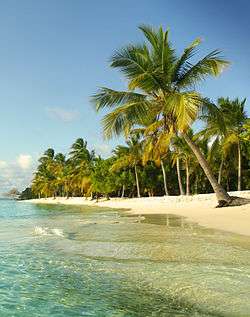
- Los Médanos de Coro National Park: Desert landscape of singular beauty, located in the heart of the city of Coro. It has an area of 91 280 hectares.
- Morrocoy National Park: Made up of keys and islets of coral origin, white sand, turquoise sea and dense mangrove forests. It has an area of 32 090 hectares.
- National Park Cueva de la Quebrada del Toro: Located in the Falconian mountain range, it has an area of 4885 hectares.
- Juan Crisostomo Falcon National Park: It has a great variety of natural attractions. It has an extension of 20,000 hectares.
- Cerro Santa Ana Natural Monument: Located in the center of Paraguaná. It has an area of 1900 hectares and an altitude of 850 meters above sea level. It was declared a Natural Monument on June 14, 1972.
Natural heritage
- Thermal waters of Cardón and Cuiva
- Guaibacoa Hot Springs
- Boca de Aroa Beach
- Adicora Beach
- Cumarebo Port Beach
- Tucacas Beaches
- Beaches in Chichiriviche
- Beaches of Morrocoy
- Manaure Well
- Tacarigua-Jatira Dam
- Hueque Falls
- Cuare Wildlife Refuge
- The Indian's Cave (Cueva del Indio)
- Haiton del Guarataro
Built heritage

- Athenaeum of Coro
- Cathedral Basilica Menor de Santa Ana
- Balcón de los Arcaya (Museum of Popular Pottery)
- Balcón Bolívar (Museum of Contemporary Art)
- House of 100 windows (Casa de las 100 ventanas)
- Casa de las Ventanas de Hierro
- Los Torres House
- House of the Sun (Casa del Sol)
- Treasury House (Casa del Tesoro)
- Alberto Henriquez House Museum (Choir Synagogue)
- Jewish cemetery in Coro
- San Clemente's Cross
- Church of San Nicolás de Bari
- San Clemente Church
- San Francisco Church
- Lucas Guillermo Castillo Diocesan Museum
- Elias David Curiel School of Music
- Hato Aguaque or Casa de Josefa Camejo
- Taima Taima Archaeological and Paleontological Museum
Infrastructure
The region is mostly coastal lowlands and the northern Andean mountain hills, and is mostly dry with limited agriculture production. Farming mostly occurs in river valleys and mountainous areas, and includes maize, coconut, sesame, coffee and sugar cane.
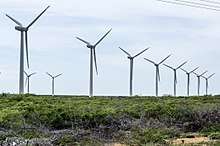
Coro, the state capitol and the Paraguaná Peninsula have had significant amounts of industrialization and growth. Large oil refineries such as the Paraguana Refinery Complex in the city of Punto Fijo are located on the southwestern shore of the Paraguaná Peninsula, and approximately two-thirds of Venezuela’s total oil production occurs in this area, much of which is exported via tanker ships that ship internationally through the port of Amuay.
Culture
Handicrafts
Falconian craftsmanship is rich in artistic expression. Within the popular handicrafts are the hammocks with unique styles, techniques and values of the state. The craft production is large and varied. The craftsmen of the towns that surround the city of Coro specialize in the manufacture of furniture with the wood of the cardon, the stick of Arch and the curarí. The wood is complemented using vegetable fibers such as sisal or with cow and goat skins. In Paraguaná the clay is worked to build objects for current domestic use, applying the same techniques used by the Caquetíos Indians. On the eastern coast the attraction is the basketwork made with bulrush, cocuiza and vines and the hammocks made with thread.
Gastronomy
The typical Falconian food allows the enjoyment of a variety of flavors represented in its specialties, such as goat talkarí, celce coriano, goat milk cheese, custard, peeled arepa and goat milk candy. At a national level, rice with coconut and rice pudding is one of the most popular sweets, especially during the Easter season.

Folklore
Folkloric, traditional and religious expressions offer a seal of originality in the state. In typical celebrations, features of African, indigenous and European cultures are associated. Among these celebrations is the Baile de las Turas, which has its origin in an indigenous dance related to the hunting season and the harvesting of the corn crop. It is celebrated in San Pedro, El Tural and Mapararí in the mountain region, between 23 and 24 September. The drum dances in the cities of Coro, La Vela and Puerto Cumarebo are very joyful and colorful, and the celebration of the Day of the Mad (December 28) in La Vela de Coro, with masked parades in the streets and public squares, reaches a display similar to that of the great carnivals of the world.
Sports

.jpg)

Sports facilities
- Pedro Conde Stadium
- José David Ugarte Stadium
- Eduardo "Tata" Amaya Stadium
- Carlos Sanchez Covered Gym
- Fenelon Diaz Covered Gym
- Ramon Pena Gilly Gym
Politics and Government
As a federal state, it is autonomous and equal in political terms to the other members of the Federation. It organizes its administration and public powers through the Federal Constitution of Falcon State of 2004, issued by the Legislative Council.
Executive Power
It is composed of the Governor of the State of Falcon and a group of State Secretaries of his confidence who are freely appointed and removed by the regional government. The Governor is elected by the people through direct and secret vote for a period of four years and with the possibility of immediate reelection for equal periods, being in charge of the state administration before the Legislative Council
The first elected governor of Falcon was Aldo Cermeño of the Social Christian Party COPEI, who would govern in the period between 1989 and 1992. The current state governor is Victor Clark, of the ruling PSUV party, elected for the 2017-2021 period.
Like the other 23 federal entities of Venezuela, the State maintains its own police force, which is supported and complemented by the National Police and the Venezuelan National Guard.
Legislative Power
The state legislature is the responsibility of the Falcon State Legislative Council. It is a unicameral and autonomous body, elected by the people through direct and secret vote every four years, and may be re-elected for two consecutive periods, under a system of proportional representation of the population of the state and its municipalities. It has 11 legislators, of which 3 are list and 8 are nominal.
See also
References
- Instituto Nacional de Estadistica, Caracas.
- "Resultado Básico del XIV Censo Nacional de Población y Vivienda 2011 (Mayo 2014)" (PDF). Ine.gov.ve. p. 29. Retrieved 8 September 2015.
External links
| Wikimedia Commons has media related to Falcón. |
- . New International Encyclopedia. 1905.